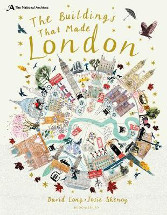The buildings that made London by David Long

Ill. by Josie Shenoy. Bloomsbury, 2018. ISBN 9781408883648
(Age: 7+) Recommended. Themes: London. Cities. History. I thoroughly
enjoyed poring over each of the double page spreads in this book,
recalling the British history taught to me as a school student in
the 1950's and 60's, admiring the illustrations of a large number of
British institutions, seen as a tourist in recent years, and for
many of today's Australian younger students, this will be a new and
delightful experience.
Amongst the many pages, I loved the Houses of Parliament, St Paul's
Cathedral, Somerset House, Westminster Abbey, Tower Bridge and the
Tower of London, all known and visited, all part of the rich
heritage explicitly taught to Australian students in the past.
Today's students would certainly know of some of the places and many
would be interested in places like Westminster Abbey and places seen
on television, or through the Royal Weddings of late, and I hope
that many would pick up this most attractive book to read and enjoy
and add to their knowledge of major cities around the world.
Each double page has a detailed drawing of the place, taken from
archival documents, and the text around the pages delineates some of
the history of that building and its place in the London of today.
It is all fascinating to me and its presentation by a teacher as
part of a unit on cities would woo an audience, but to pick it up to
ponder over the heritage of one of the world's most beautiful cities
would be enough for many readers.
The double page spread about the Victoria and Albert Museum, for
example, has a drawing which covers both pages, illustrated around
the edges with some of the exhibits housed within. The people in the
front represent those who have visited the museum over the decades,
and reading the text at the top of the pages, reveals some of the
history of the building as well as some of the most wellknown
pieces to be found inside. I was surprised to find that it was built
in 1890 to replace an ugly building already there and that the guide
was published in French during World War Two to assist the French
refugees residing in London at the time.
This like other pages is detailed and evocative, but the highlight
of the book are the central pages devoted to Buckingham Palace. Here
the publication has flaps which show the palace as it was and how it
is today. Eager readers will devour each piece of information and
take in the fabulously detailed illustrations.
Fran Knight